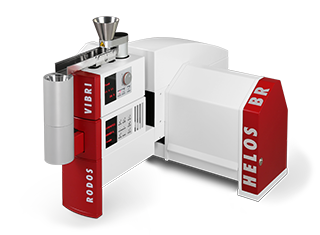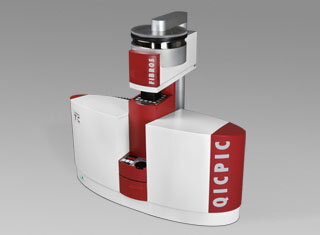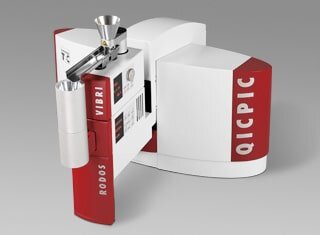Dynamic image analysis for free-flowing powders and granules from 1.8 µm to 18,000 µm with gentle dispersion in free fall
The system configuration comprising image analysis sensor QICPIC, gravity disperser GRADIS/L and dosing unit VIBRI/L is the first choice for the analysis of size and shape of free-flowing, compact particles from 1.8 µm to 18,000 µm that require only low dispersing forces. The gentle dispersion in the free fall shaft of the GRADIS is recommended in particular for metastable particles and coarse grained samples with a low fines content, such as granules, crystals or sand. The characterisation of slender, elongated or even rolled-up fibres is also possible for lengths significantly above 10 mm.
The system can be used for sample amounts ranging from a few grams into the kilogram range. The dosing of the sample is performed with the precision vibratory feeder VIBRI/L, which guarantees optimum concentration of the sample in the measuring zone with a consistent, controlled product supply. In the GRADIS free fall shaft, the acceleration under gravity and the integrated impact-plate cascade ensure gentle dispersion with slight particle-to-wall and particle-to-particle collisions. Replaceable outlet tips with aperture sizes of 0.5 | 1 | 2 | 4 | 10 or 20 mm are used to adapt the free fall shaft to the sample material. Extraction generates laminar flow conditions in the free fall shaft and in the measuring zone and serves for the disposal of the sample after measurement. Alternatively, a collecting tray is available for recovery of the sample. The free fall shaft can be disassembled into two halves for cleaning. For special applications, the free fall shafts can also be optionally supplied with PTFE coating (conductive or non-conductive).
The use of the dynamic image analysis enables optimised comparability of the measurement results with those of a traditional sieve analysis. With sieving, the particles orient themselves in such a way that they pass through the sieve with their smallest cross-section. Accordingly, the selection of a comparable shape parameter as a measure of the particle size is a basic requirement for a valid comparison of methods. Particles that tend to be more compact are therefore best described by the minimum Feret diameter and fibres by their fibre thickness, respectively. As a result of the gravity dispersion (with or without air flow), the dispersion performance in the GRADIS system is also comparable to that of a sieve analysis in a sieve stack.
- Particle size, particle shape, fibre characterisation
- For dry, free-flowing powders, fibres and granules
- For laboratory analyses
- Sample amount per analysis 10 g to 1,000 g
- 5 high-resolution measuring ranges from 1.8 µm to 18,000 µm (upper limit for compact particle shapes) | M5 to M9
- Characterisation of slender fibres even with lengths over 10 mm
- Gentle dispersion under the force of gravity in a free fall shaft
- With extraction or collecting tray for sample recovery
The modular concept of the QICPIC image analysis sensors allows this configuration to be systematically expanded with numerous dispersion units and dosing options, thereby opening it up to many more product-appropriate measuring applications.













